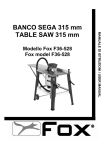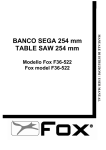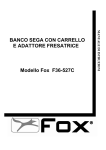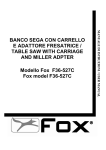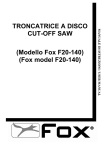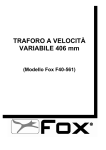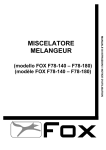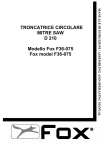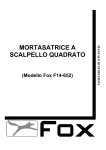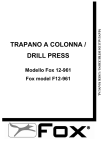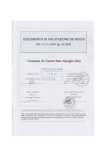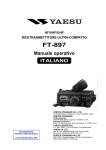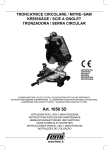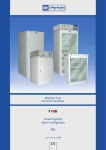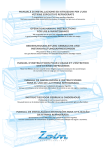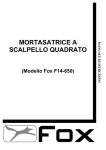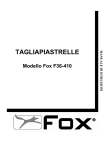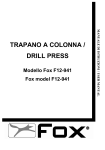Download BANCO SEGA 254 mm CON BASE RIPIEGABILE
Transcript
(Modello Fox F36-521) (Fox Model F36-521) MANUALE DI ISTRUZIONI / USER MANUAL BANCO SEGA 254 mm CON BASE RIPIEGABILE 254 mm TABLE SAW WITH FOLDING BASE SOMMARIO / INDEX FIGURE ILLUSTRATIVE / ILLUSTRATING PICTURES ITALIANO (IT) Manuale originale, Original manual ENGLISH (EN) Manuale tradotto dall’originale / Manual translated from the original 3÷5 6÷28 29÷51 DICHIARAZIONE DI CONFORMITA / DECLARATION OF CONFORMITY 52 ESPLOSO / EXPLODED VIEW 53 SCHEMA ELETTRICO / WIRING DIAGRAM 57 2 FIGURE ILLUSTRATIVE 3 4 5 Banco sega 254 mm con base ripiegabile (Modello F36-521) SOMMARIO • • • • • • • • • • • • • • • • • • • • • • • • • • • • • • • • • • • • • • • • Sicurezza Regole generali di sicurezza Regole supplementari di sicurezza per le seghe circolari Regole di sicurezza per il puntatore laser Protezione dell’ambiente Simboli Collegamento alla corrente elettrica Uso conforme alle norme Caratteristiche tecniche Informazioni sul rumore Disimballo Descrizione del banco sega Montaggio del basamento Regolazione dell’altezza della base Montaggio dell’estensione posteriore del piano di lavoro Montaggio e regolazione delle estensioni laterali Montaggio del coltello divisore e del laser Montaggio e smontaggio della protezione lama Montaggio dei supporti per lo spingipezzo Ripiegamento del basamento Spostamento del banco sega Regolazione del raggio laser Avvio del banco sega Regolazione dell’altezza di taglio Utilizzo della guida parallela Utilizzo del goniometro Regolazione dell’inclinazione della lama Lavori di taglio Taglio d’angolo a 45° Taglio trasversale Taglio inclinato trasversale Taglio obliquo Taglio composto Utilizzo dello spingipezzo Rifilatura inclinata Sostituzione della lama Aspirazione delle polveri Manutenzione Anomalie di funzionamento Assistenza 6 Pag. 7 Pag. 8 Pag. 10 Pag. 11 Pag. 12 Pag. 12 Pag. 13 Pag. 14 Pag. 15 Pag. 15 Pag. 16 Pag. 17 Pag. 19 Pag. 19 Pag. 19 Pag. 19 Pag. 20 Pag. 20 Pag. 21 Pag. 21 Pag. 21 Pag. 21 Pag. 22 Pag. 22 Pag. 22 Pag. 23 Pag. 23 Pag. 23 Pag. 24 Pag. 24 Pag. 24 Pag. 24 Pag. 24 Pag. 25 Pag. 25 Pag. 25 Pag. 26 Pag. 26 Pag. 27 Pag. 28 SICUREZZA ATTENZIONE: Quando si utilizzano utensili elettrici si dovrebbero sempre rispettare, oltre a quelle riportate in questo manuale, tutte le precauzioni base di sicurezza per ridurre il rischio di incendio, scossa elettrica e danni personali. Leggere attentamente tutte queste istruzioni prima di utilizzare questo prodotto e conservarle scrupolosamente. Le lavorazioni effettuate con un elettroutensile possono diventare pericolose per l’operatore se non vengono rispettate norme operative sicure ed adeguate. Come per qualsiasi macchina elettrica che ha un organo di lavoro in movimento, l’utilizzo dell’utensile comporta alcuni rischi. Se la macchina viene utilizzata come indicato su questo manuale, prestando la massima attenzione al lavoro che si sta facendo, rispettando le regole ed utilizzando gli adeguati dispositivi di protezione individuale, la probabilità di incidenti sarà quasi nulla. I possibili rischi residui sono relativi a: 1 – contatti diretti od indiretti con la scossa elettrica 2 – ferimenti per contatto con parti rotanti in movimento 3 – ferimenti per contatto con parti spigolose 4 – ferimenti per eiezioni di parti di utensile o di materiale in lavorazione 5 – danni causati dal rumore 6 – danni causati dall’inalazione di polveri pericolose 7 – ferimenti per utensili montati male Le attrezzature di sicurezza previste sulle macchine, come le protezioni, i carter, gli spingipezzo, i dispositivi di ritenuta, i dispositivi di protezione individuale come gli occhiali, le maschere antipolvere, le protezioni auricolari, le scarpe e i guanti possono ridurre le probabilità di incidente. Anche la migliore protezione, però, non può proteggere contro la mancanza di buon senso e di attenzione. Abbiate sempre buon senso e prendete le precauzioni necessarie. Fate solo i lavori che ritenete siano sicuri. NON DIMENTICATE: la sicurezza è responsabilità di ognuno. Questo utensile è stato concepito per un utilizzo ben preciso. DELTA France raccomanda di non modificarlo o di non utilizzarlo per scopi diversi rispetto a quelli per cui è stato costruito. Se avete dei dubbi relativamente ad applicazioni specifiche, NON utilizzate l’utensile prima di aver contattato DELTA France e aver ricevuto informazioni in merito. LEGGETE E CONSERVATE QUESTO MANUALE 7 REGOLE GENERALI DI SICUREZZA 1. Mantenete l’area di lavoro pulita. Nelle zone o nei banchi di lavoro ingombri è più alta la probabilità di incidenti. 2. Evitate un ambiente pericoloso. Non esponete gli utensili alla pioggia e non utilizzateli in ambienti umidi o bagnati, per evitare i fenomeni di elettrolocuzione. Mantenete la zona di lavoro ben illuminata. Non utilizzate l’utensile in presenza di gas o di liquidi infiammabili. 3. Collegate il dispositivo di aspirazione della polvere. Se sono previsti dei metodi per il recupero della polvere, assicuratevi che questi dispositivi siano collegati e utilizzati correttamente. 4. Tenete gli estranei e i bambini lontani. Tutti gli estranei e i bambini devono mantenere una distanza di sicurezza dall’area di lavoro. 5. Proteggetevi dalle scariche elettriche. Evitate di entrare in contatto con delle superfici di messa a terra. 6. Non maltrattate il cavo elettrico. Non tirate mai il filo elettrico per scollegarlo dalla presa. Mantenete il cavo elettrico lontano dal calore, dall’olio e dagli spigoli vivi. 7. Utilizzate delle prolunghe elettriche previste per l’esterno. Quando l’utensile viene utilizzato all’esterno, utilizzate solamente delle prolunghe elettriche previste per l’esterno e che riportino delle indicazioni in merito. 8. Siate vigili. Osservate attentamente quello che fate, abbiate buon senso. Non utilizzate l’utensile quando siete affaticati. 9. Non utilizzate l’utensile se siete sotto l’effetto di medicinale, alcol, droghe. 10. Evitate l’avvio accidentale. Assicuratevi che l’interruttore sia nella posizione di arresto prima di collegare l’utensile. 11. Indossate una tenuta appropriata. Non indossate vestiti ampi o gioielli che possono impigliarsi nei pezzi mobili. Per il lavoro all’esterno sono particolarmente raccomandate le scarpe antiscivolo. Portate un mezzo di protezione per i capelli lunghi. 12. Usate sempre i dispositivi di protezione personale: portate gli occhiali di sicurezza e mascherine nei casi in cui si producano polveri o trucioli. Indossate cuffie antirumore o tappi protettivi in ambienti rumorosi. Usate guanti quando si maneggiano particolari con spigoli vivi e taglienti. 13. Non sbilanciatevi sopra all’utensile. Mantenete sempre il vostro equilibrio. 14. Chiedete consigli a persone esperte e competenti se non avete familiarità con il funzionamento dell’utensile. 15. Allontanate gli utensili inutilizzati. Quando gli utensili non vengono utilizzati, devono essere sistemati in un luogo secco, chiuso a chiave, fuori dalla portata dei bambini. 8 16. Non forzate l’utensile. La lavorazione sarà migliore e maggiormente sicura se l’utensile viene utilizzato al ritmo per il quale è stato concepito. 17. Utilizzate l’utensile appropriato. Non forzate un piccolo utensile a fare il lavoro di un utensile a utilizzo intensivo. Per esempio, non utilizzate una sega circolare per tagliare dei rami o dei ceppi. 18. Fissate il pezzo. Utilizzate per quanto possibile dei morsetti a vite o una morsa per bloccare il pezzo. E’ più sicuro che servirsi delle sole mani. 19. Mantenete gli utensili in perfetto stato. Tenete gli utensili affilati e puliti in modo da ottenere un rendimento migliore e più sicuro. Seguite le istruzioni per lubrificare e sostituire gli accessori. Controllate regolarmente il cavo elettrico e sostituitelo se è danneggiato. Tenete le maniglie e le impugnature secche, pulite e prive di olio e di grasso. 20. Scollegate l’utensile dalla rete quando non è utilizzato, prima della manutenzione e della sostituzione degli accessori o utensili quali lame, punte, le frese, ecc. 21. Allontanate le chiavi di serraggio e di regolazione. Prendete l’abitudine di verificare che le chiavi di serraggio e di regolazione siano state allontanate dall’utensile prima di avviarlo. 22. Controllate i particolari dell’utensile per verificare che non ci siano parti danneggiate. Prima di continuare ad utilizzare l’utensile, controllate tutti i dispositivi di sicurezza o qualsiasi altro pezzo che possa essere danneggiato in modo da assicurarvi che funzioni bene e che riesca ad effettuare il compito previsto. Verificate che i pezzi mobili siano ben allineati, non si blocchino e non siano rotti. Controllate anche il montaggio o qualsiasi altra condizione che può influenzare il funzionamento. Qualsiasi pezzo o qualsiasi protezione danneggiata deve essere riparata o sostituita da un centro di servizio post-vendita autorizzato. Non utilizzate l’utensile se l’interruttore non funziona correttamente. 23. Utilizzate l’elettroutensile, gli utensili e gli accessori nel modo e per gli scopi riportati in questo manuale; utilizzi e componenti diversi possono generare possibili rischi per l’operatore. 24. Fate riparare l’utensile da una persona competente. Questo utensile elettrico è conforme alle prescrizioni di sicurezza corrispondenti. Le riparazioni devono essere realizzate solo da persone qualificate che utilizzino ricambi originali, altrimenti potrebbero insorgere dei pericoli per l’utilizzatore. 9 REGOLE DI SICUREZZA GENERALI PER LE SEGHE CIRCOLARI 1. NON AVVIATE la sega finché non è completamente assemblata e installata secondo le direttive del presente manuale. 2. UTILIZZATE sempre la protezione lama, il coltello divisore e lo spingipezzo per “tagliare completamente”. Con questa espressione si intende “tagliare interamente” il pezzo in tutto il suo spessore. 3. TENETE sempre il pezzo ben appoggiato alla guida obliqua o alla guida di taglio parallela. 4. UTILIZZATE sempre uno spingipezzo per fare avanzare il legno oltre la lama e in particolare per tagliare i pezzi piccoli. Per dettagli più specifici sullo spingipezzo, vedere le sezioni sul taglio in lungo in queste istruzioni. 5. NON LAVORATE mai a “mano libera”. Utilizzate sempre la guida obliqua o la guida di taglio parallela per posizionare e guidare il pezzo da tagliare. 6. NON POSIZIONATEVI mai nell’asse della lama. TENETE le mani distanti dalla traiettoria della lama. 7. NON PASSATE mai le mani dietro o sopra la lama ed evitate di assumere posizioni scomode con le mani e il corpo. 8. ALLONTANATE la guida di taglio parallela durante il taglio trasversale. 9. NON UTILIZZATE MAI la guida di taglio parallela come guida di tranciatura per il taglio trasversale. 10. FATE sempre avanzare il pezzo da tagliare contro la lama o l’utensile. 11. NON TENTATE MAI di sbloccare la lama senza prima arrestare l’utensile. Anche se volete interrompere il taglio, mettete l’interruttore in posizione di arresto e aspettate che la lama si fermi. Intervenite solo con lama ferma e in mancanza di alimentazione elettrica. 12. EVITATE di togliere pezzi di legno incastrati tra lama e asola con la lama in movimento. Spegnete la macchina e aspettate che la lama si fermi, poi intervenite. 13. APPOGGIATE su dei cavalletti le estremità dei grandi pezzi che fuoriescono lateralmente o posteriormente dal banco della sega; create delle condizioni di stabilità per i materiali da tagliare, per evitare pericolose cadute al termine del taglio. 14. EVITATE gli arretramenti violenti (pezzo che viene proiettato verso se stesso): A. lavorando sempre con una lama ben affilata e adatta al materiale da tagliare; B. controllando il parallelismo tra la guida e la lama; C. utilizzando sempre il coltello divisore, lo spingipezzo e la protezione della lama; D. non rilasciando il pezzo fino a quando non sia completamente tagliato; E. evitando pezzi storti o deformati che non hanno un lato rettilineo che permette di farli avanzare uniformemente lungo la guida. 10 15. NON UTILIZZATE mai dei solventi per pulire i pezzi in plastica. I solventi possono sciogliere o danneggiare il materiale. Utilizzate solamente uno straccio umido per pulire i pezzi in plastica. 16. INSTALLATE la sega in maniera PERMANENTE su una superficie in piano prima di utilizzarla. 17. NON TAGLIATE mai dei metalli o dei materiali che possano produrre della polvere pericolosa. 18. UTILIZZATE sempre il banco sega in un ambiente ben areato. Eliminate frequentemente la segatura. Rimuovete bene la segatura che si trova all’interno della sega per evitare il rischio di incendio. 19. NON UTILIZZATE delle lame danneggiate o deformate o lame in acciaio rapido ad alta lega ( tipo HSS ). 20. UTILIZZATE solamente delle lame raccomandate dal fabbricante, conformi alla norma EN 847-1. 21. UTILIZZATE lame adatte al materiale da tagliare e che abbiano marcata una velocità maggiore di quella riportata sulla targa della macchina. Quando si sostituisce la lama, verificare che il diametro esterno e il diametro del foro siano giusti, che la larghezza del taglio della lama non sia inferiore allo spessore del coltello divisore e che lo spessore del corpo lama non sia superiore a quella del coltello divisore. Trasportate sempre la lama all’interno della sua custodia. 22. SOSTITUITE l’inserto in plastica posto sul piano attorno alla lama quando è usurato o danneggiato. 23. UTILIZZATE questo banco sega solamente per tagliare il legno e materiali simili. 24. CONTROLLATE regolarmente se il cavo di alimentazione è danneggiato, nel qual caso fatelo riparare da un centro servizio post-vendita autorizzato. Controllate regolarmente le prolunghe e sostituitele se sono danneggiate. 25. COLLEGATE un sistema di estrazione della polvere ed USATE protettori acustici e mascherina antipolvere. REGOLE DI SICUREZZA PER IL PUNTATORE LASER • • • • • • • Non guardate mai in direzione del puntatore laser. Non orientate il laser verso persone o animali. Non utilizzate il puntatore laser su materiali molto riflettenti. La luce riflessa è tanto pericolosa quanto quella diretta. Fate riparare il puntatore laser solamente da tecnici qualificati. Non toccate la lente del laser con degli oggetti duri. Pulite la lente del laser tramite una spazzola morbida e secca. L’eventuale sostituzione del puntatore va fatta con uno dello stesso tipo. 11 PROTEZIONE DELL’AMBIENTE INFORMAZIONE AGLI UTENTI Ai sensi dell’art.13 del Decreto Legislativo 25 luglio 2005, n.151 “Attuazione delle Direttive 2002/95/CE, 2002/96/CE, e 2003/108/CE, relative alla riduzione dell’ uso di sostanze pericolose nelle apparecchiature elettriche ed elettroniche, nonché allo smaltimento dei rifiuti”, si precisa quanto segue: • Il simbolo del cassonetto barrato riportato sull’apparecchiatura o sulla confezione indica che il prodotto alla fine della propria vita utile deve essere raccolto separatamente dagli altri rifiuti. • L’utente dovrà, pertanto, conferire l’apparecchiatura giunta a fine vita agli idonei centri di raccolta differenziata dei rifiuti elettronici ed elettrotecnici, oppure riconsegnarla al rivenditore al momento dell’ acquisto di una nuova apparecchiatura di tipo equivalente, in ragione di uno ad uno. • L’adeguata raccolta differenziata per l’avvio successivo dell’apparecchiatura dismessa al riciclaggio, al trattamento ed allo smaltimento ambientalmente compatibile, contribuisce ad evitare possibili effetti negativi sull’ambiente e sulla salute e favorisce il reimpiego e/o riciclo dei materiali di cui è composta l’apparecchiatura. ATTENZIONE! Lo smaltimento abusivo del prodotto da parte dell’utente comporta l’applicazione delle sanzioni amministrative previste dalla normativa vigente SIMBOLI Leggere attentamente il manuale di istruzioni Utilizzare dispositivi individuali di protezione (occhiali, maschera antipolvere e cuffie) E’ vietato inserire le mani in questa zona, utensile in funzione. Pericolo di trascinamento/taglio 12 Indica il servizio sull’utensile di un puntatore laser (vedi paragrafo REGOLE DI SICUREZZA PER IL PUNTATORE LASER). Matricola/anno costruzione COLLEGAMENTO DELL’UTENSILE ALLA CORRENTE ALLACCIAMENTO ELETTRICO Per l’alimentazione della vostra macchina è necessaria una tensione alternata a 230 V 50 Hz con conduttore di terra. Assicuratevi che la vostra alimentazione abbia queste caratteristiche, che sia protetta da un interruttore differenziale e magnetotermico e che l’impianto di terra sia efficiente. Se la vostra macchina non funziona quando è collegata ad una presa, verificate attentamente le caratteristiche dell’alimentazione. ISTRUZIONI PER LA MESSA A TERRA Presa di corrente con terra Conduttore di terra Presa della macchina In caso di cattivo funzionamento o di corto circuito dell’utensile, la messa a terra fornisce un cammino di minore resistenza alla corrente elettrica e riduce il rischio di scarica elettrica. Questo utensile è dotato di un cavo elettrico che possiede un conduttore di messa a terra e una spina con il contatto di terra. La spina deve essere collegata ad una presa corrispondente correttamente installata e messa a terra in conformità alle normative e disposizioni locali. Assicuratevi della bontà del vostro impianto di terra e che la vostra presa sia protetta a monte da un interruttore differenziale e magnetotermico. Non modificate la spina fornita. Se non entra nella presa, fate installare una presa appropriata da un elettricista qualificato. Un collegamento mal fatto del conduttore della messa a terra dell’attrezzo può comportare il rischio di scarica elettrica. Il conduttore la cui guaina isolante è verde con o senza linea gialla è il conduttore della messa a terra. Se risulta necessaria la riparazione o la sostituzione del cavo di alimentazione, non collegate il conduttore di terra ad un morsetto sotto tensione. Informatevi presso un elettricista qualificato o da una persona responsabile della manutenzione se non avete compreso o avete qualche dubbio sulle istruzioni della messa a terra. Se il cavo di alimentazione è danneggiato deve essere sostituito da centri assistenza autorizzati o da personale qualificato. Non fate funzionare l’utensile se il cavo di alimentazione è danneggiato. Questo utensile è dotato di una spina che deve essere collegata ad una presa adeguata. 13 PROLUNGHE ELETTRICHE Utilizzate solamente delle prolunghe elettriche a tre conduttori con una spina a due spinotti e contatto di terra e delle prese a due cavità e una terra corrispondente alla spina dell’utensile Quando utilizzate un utensile elettrico ad una distanza considerevole dall’alimentazione, assicuratevi di utilizzare una prolunga di dimensioni sufficienti per trasportare la corrente di cui l’utensile ha bisogno. Una prolunga sotto dimensionata provocherebbe una caduta di tensione elevata nella linea, con perdita di potenza e conseguente surriscaldamento del motore. Possono essere utilizzate solamente delle prolunghe conformi alle norme CE . Lunghezza della prolunga elettrica: fino a 15 m Dimensioni del cavo: 3 x 2,5 mm² Prima di utilizzare qualsiasi prolunga, verificate che non abbia dei fili scoperti e che l’isolante non sia tagliato o usurato. Riparate o sostituite immediatamente la prolunga danneggiata o usurata. ATTENZIONE: Le prolunghe devono essere sistemate fuori dalla zona di lavoro per evitare che possano entrare in contatto con i pezzi in lavoro, l’utensile o altri particolari della macchina e creare possibili rischi. ATTENZIONE: TENETE GLI UTENSILI E L’ATTREZZATURA FUORI DALLA PORTATA DEI BAMBINI USO CONFORME ALLE NORME Questo utensile è stato progettato e realizzato per il taglio longitudinale e trasversale di legno tenero e duro, pannelli di legno ricoperti e materiali simili. La lama può essere inclinata da 0 a 45° e nella posizione a 0° può tagliare uno spessore di legno di 75 mm, mentre con la lama inclinata di 45° lo spessore di legno tagliabile è di 50 mm. Non è stata omologata per il taglio dell’alluminio e dei metalli ferrosi e non ferrosi. 14 CARATTERISTICHE TECNICHE Potenza motore: Tensione di alimentazione e frequenza: Tipo di servizio: Diametro della lama: Spessore del corpo lama montato: Larghezza di taglio lama montata: Diametro del foro lama Alesaggio della lama: Numero di denti della lama: Velocità: Cuneo, spessore e larghezza asola: Profondità massima di taglio: 1800 W 230 V - 50 Hz S6 40% 254 mm 1,6 mm 2,8 mm 30 mm 24 denti 5700 giri/min. 2 mm – 8,2 mm a 90° : 75 mm a 45° : 50 mm 660 x 540 mm 1220 x 860 mm 0-45° 1° < 111 mW 26 kg Dimensioni del piano: Dimensioni con estensioni comprese: Inclinazione della lama: Classe del puntatore laser: Potenza del laser: Peso netto: INFORMAZIONI SUL RUMORE Il rumore emesso, misurato conformemente alle norme EN61029, EN3744 e EN11201 è risultato essere : - Livello di pressione acustica LpA = 99,1 dB(A) - Livello di potenza sonora LWA = 110,4 dB(A) - Incertezza della misura K = 3 dB. Si consiglia di indossare adeguati protettori acustici. Le sorgenti del rumore della sega sono il motore elettrico e la sua ventilazione, il riduttore di velocità a cinghia, la lama e ovviamente il materiale da tagliare. Per il motore e la sua ventilazione si consiglia di tenerlo controllato e di pulire i passaggi dell’aspirazione, per il riduttore di verificare lo stato e il tensionamento della cinghia, per le lame di utilizzare tipi silenziati e di tenerle sempre in perfetta efficienza e per il materiale da tagliare di usare le lame giuste e di tenere sempre ben bloccati i particolari da tagliare. I valori indicati per il rumore sono livelli di emissione e non necessariamente livelli di lavoro sicuro. Mentre vi è una correlazione tra livelli di emissione e livelli di esposizione, questa non può essere usata con sicurezza per determinare se siano richieste o no ulteriori precauzioni. I fattori che influenzano il reale livello di esposizione del lavoratore includono la durata dell’esposizione, le caratteristiche dell’ambiente, altre sorgenti di rumore, per esempio il numero di macchine e altre lavorazioni adiacenti. Inoltre i livelli di esposizione possono variare da un Paese a Paese. Queste informazioni mettono comunque in grado l’utilizzatore della macchina di fare la miglior valutazione dei pericoli e dei rischi. 15 DISIMBALLO Nell’imballo della sega sono contenuti: 1. Banco sega 2. Goniometro con appoggio 3. Gruppo bloccaggio completo di guida 4. Spingipezzo 5. Estensioni del piano di lavoro (n°3 pezzi) 6. Due ruote 7. Due supporti laterali 8. Viti necessarie per i montaggio 9. Tubo di aspirazione 10. Protezione lama 11. Coltello divisore con laser 12. Lama 13. Manuale 14. Due batterie mini stilo per il laser Togliere la sega e tutti i vari componenti dall’imballo, verificare che non manchi nulla e che non ci sia niente di danneggiato. Nel caso fossero presenti parti difettose o rovinate non utilizzarle per non compromettere l’efficienza e la sicurezza dell’utensile. Rivolgersi ad un centro assistenza autorizzato per la sostituzione dei particolari difettosi. Per rendere perfettamente funzionante il banco sega devono essere montati vari particolari, per i quali viene data una dettagliata spiegazione nel seguito. Si consiglia di leggere attentamente le istruzioni di montaggio e di seguirle alla lettere. La sega, una volta montata, deve essere posizionata per il suo utilizzo, su una superficie perfettamente livellata, in un ambiente al coperto, pulito, sgombro, ben aerato e con un livello di illuminamento medio. 16 DESCRIZIONE DEL BANCO SEGA La macchina è composta da: 17 1. 2. 3. 4. 5. 6. 7. 8. 9. 10. 11. 12. 13. 14. 15. 16. 17. 18. 19. 20. 21. 22. 23. 24. 25. 26. 27. 28. 29. 30. 31. 32. 33. 34. Piano di lavoro Interruttore avvio / arresto Supporti per alloggiamento del cavo della macchina Manopola di trasporto Arresto in gomma x 2 Binario del goniometro Alloggio della lama di scorta Coltello divisore e laser Interruttore avvio / arresto del laser Vite di regolazione del laser x 2 Vite di accesso alle pile del laser x 2 Inserto del piano di lavoro Guida parallela Leva di bloccaggio della guida parallela Scala di gradazione della guida parallela Goniometro Protezione della lama Fori di estrazione della polvere, uno sul carter e uno nella parte posteriore Volantino di discesa e di salita della lama Leva di bloccaggio della lama Volantino di inclinazione della lama Indicatore di inclinazione della lama Scala di inclinazione della lama Prolunga posteriore della tavola Prolunga laterale x 2 Bloccaggio delle prolunghe laterali x 4 Base ripiegabile Supporto dell’estensione posteriore x 2 Fissaggio e ruote di trasporto x 2 Piedi regolabili Spingipezzo Lama di taglio di scorta Pezzi per il fissaggio dello spingipezzo Tubo aspirante per le polveri 1. Capovolgete la tavola e il corpo della tavola su del cartone in modo da proteggere la superficie del piano d lavoro. Levate le viti di sicurezza situate sul basamento in modo da poter togliere la piastra inferiore. Togliete il cartone e il polistirolo di protezione posti attorno al motore e alla lama (protezione necessaria per il trasporto). Infine, rimettete la piastra inferiore e riavvitate le viti di fissaggio della stessa. 2. 3. 4. 18 MONTAGGIO DEL BASAMENTO 1. 2. Successivamente, aprite il basamento del banco sega (Fig. 1). Seguite la procedura inversa alla sistemazione del basamento riferendovi al paragrafo intitolato “Ripiegamento del basamento”. Notate che i piedi possono essere piegati o ripiegati solamente quando il meccanismo di blocco è scollegato tirando questi ultimi (Fig. 2). Assicuratevi che i piedi siano bloccati nella corretta posizione quando il basamento è completamente ripiegato. Fissate le due ruote di trasporto utilizzando i pezzi di fissaggio (29) al basamento, usando le 4 viti M6x40 mm così come le viti e le rondelle corrispondenti (Fig. 3 e 4). REGOLAZIONE DELL’ALTEZZA DELLA BASE 1. 2. 3. Posizionate il banco sega nel luogo desiderato. Allentate il contro dado del piede regolabile (Fig. 5) (30) e avviate o svitate questo piede per accorciarlo o allungarlo fino a che il piano di lavoro sia in piano (Fig. 6). In seguito stringete il contro dado del piede regolabile. MONTAGGIO DELL’ESTENSIONE POSTERIORE DEL PIANO DI LAVORO 1. 2. 3. 4. Utilizzate le due viti M6x12 mm con le rondelle corrispondenti per fissare l’estensione posteriore del piano di lavoro (24) al piano (1). Utilizzate le due viti M6x12 mm con le rondelle e dadi corrispondenti per fissare i supporti dell’estensione posteriore del piano di lavoro (28) all’angolo esteriore dell’estensione posteriore del piano di lavoro (24) (Fig. 7 e 8). Fissate i supporti dell’estensione posteriore del piano di lavoro (28) inserendo le due viti autofilettanti da 17 mm nei fori situati sui lati del telaio del banco sega (Fig. 9). Controllate che l’estensione posteriore del piano di lavoro sia parallela rispetto al telaio e a livello del piano di lavoro, e regolatela se necessario. PERICOLO: PRIMA DI QUALSIASI INTERVENTO ASSICURATEVI CHE LA MACCHINA SIA SCOLLEGATA DALLA PRESA DELLA CORRENTE MONTAGGIO E REGOLAZIONE DELLE ESTENSIONI LATERALI 1. 2. 3. 4. 5. Togliete la vite autofilettante situata alla fine di ogni perno dell’estensione laterale (25). Allentate le due viti di bloccaggio (26) e fate scorrere i perni dell’estensione laterale nei fori situati al di sotto del piano di lavoro (Fig. 10 e 11). Inserite completamente l’estensione laterale e rimettete le due viti autofilettanti. Regolate l’estensione laterale nella posizione desiderata e stringete le due viti di bloccaggio (26). Ripetete la stessa operazione per l’altra estensione laterale. 19 MONTAGGIO DEL COLTELLO DIVISORE E DEL LASER AVVERTENZA: Spegnete l’interruttore e scollegate la sega dalla corrente, togliendo la spina del cavo dalla presa di corrente prima di qualsiasi regolazione, riparazione, manutenzione o sostituzione della lama. 1. 2. 3. 4. 5. 6. 7. 8. Togliete le viti di fissaggio situate sull’inserto del piano di lavoro (12) (Fig. 12) e rimuovetelo (Fig. 13). Azionate la manopola di sbloccaggio della lama e ruotate la manopola di regolazione dell’altezza della lama (19) in modo che la lama sia nella posizione più alta (Fig. 15). Azionate la manopola di bloccaggio della lama (20). Svitate il bullone situato sull’elemento di attacco del coltello divisore e inserite il coltello divisore tra la piastra metallica e il blocco di plastica (Fig. 16). Regolate l’altezza del coltello divisore in modo che lo spazio tra il coltello divisore e i denti della lama sia regolare lungo tutto il perimetro della lama e non ecceda i 5 mm di larghezza. Stringete il bullone per bloccare fermamente il coltello divisore. Accertatevi che il coltello sia perfettamente allineato con la lama. Riposizionate l’inserto del piano di lavoro (12) (Fig. 17). Fissate la scatola che contiene il laser al coltello divisore con le due viti e i due dadi autobloccanti, e accertatevi di aver montato le due pile (vedi “ Manutenzione ”). MONTAGGIO E SMONTAGGIO DELLA PROTEZIONE DELLA LAMA AVVERTENZA: Spegnete l’interruttore e scollegate la sega dalla corrente, togliendo la spina del cavo dalla presa di corrente prima di qualsiasi regolazione, riparazione, manutenzione o sostituzione della lama. 1. 2. 3. 4. 5. 6. Per togliere la protezione della lama (17), allentate la vite e il dado ad alette per far scivolare il carter in modo da estrarlo (Fig. 18). Per rimontare la protezione (17), mettetela sopra il coltello divisore (8) e posizionatela in modo che la vite passi attraverso il foro situato sul coltello divisore. (Fig. 19). Regolate la protezione in modo che la vite sia posizionata nel foro. Stringete il dado in modo che la protezione sia sufficientemente stabile, ma libera e possa alzarsi quando il pezzo in lavoro la dovrà sollevare. .B.: la protezione della lama (17) deve poter ritornare nella sua posizione iniziale dopo che il pezzo è stato tagliato. Collegate il tubo di aspirazione delle polveri sull’attacco dello scarico delle polveri (18) situato nella parte superiore della protezione della lama (17). Una fascetta di serraggio è fornita per facilitare la connessione (Fig. 20). L’altra parte del tubo va collegata all’attacco aspiratore (18), situato nella parte posteriore. Su questo attacco, nell’altro foro libero, deve essere collegato un sistema di estrazione esterno, per eliminare le polveri prodotte nel taglio e ridurre il rischio di inalazioni polveri. ATTENZIONE: la protezione della lama (17) deve essere in posizione bassa in qualsiasi momento per evitare il contatto con la lama. Deve alzarsi solamente durante il passaggio del pezzo da lavorare. 20 MONTAGGIO DEI SUPPORTI PER LO SPINGIPEZZO 1. 2. Utilizzate le 4 viti 3,2 mm x 10 mm fornite per montare i due pezzi sui quali alloggeremo lo spingipezzo nel fianco destro del basamento. Inserite lo spingipezzo nei supporti. N.B.: Sistemate sempre lo spingipezzo nel suo alloggio quando non ne fate uso. RIPIEGAMENTO DEL BASAMENTO AVVERTENZA: Spegnete l’interruttore e scollegate la sega dalla corrente, togliendo la spina del cavo dalla presa di corrente prima di qualsiasi regolazione, riparazione, manutenzione o sostituzione della lama. 1. 2. 3. 4. Inclinate la sega, sbloccate i piedi nella parte sinistra della sega e ripiegateli in maniera che siano posizionati sul suolo come illustrato (Fig. 22 e 23). Ripiegateli completamente contro la parte inferiore della macchina (Fig. 24). Per fare questo, inclinate la sega in modo che sia appoggiata solo sulle ruote di trasporto e sugli arresti in gomma situati sull’estensione laterale sinistra (Fig. 25). Ripiegate il secondo paio di piedi dopo averli sbloccati (Fig. 26). SPOSTAMENTO DEL BANCO SEGA AVVERTENZA: Assicuratevi che il banco sega sia spento e scollegato da qualsiasi fonte di corrente. 1. 2. 3. 4. 5. Avvolgete il cavo di alimentazione attorno agli appositi ganci (3) per evitare qualsiasi disturbo. Assicuratevi che la lama sia abbassata al di sotto del livello del piano di lavoro. Ripiegate il basamento come illustrato. Tirate l’impugnatura (4) (Fig. 27) per estrarla. Grazie a questa impugnatura per il trasporto potete posizionare il banco sega nel luogo desiderato (Fig. 28). REGOLAZIONE DEL PUNTATORE LASER AVVERTENZA: Spegnete l’interruttore e scollegate la sega dalla corrente, togliendo la spina del cavo dalla presa di corrente prima di qualsiasi regolazione, riparazione, manutenzione o sostituzione della lama. 1. 2. Per regolare il raggio del laser, prendete prima di tutto un pezzo di legno rettangolare di circa 100 mm di larghezza e 300 mm di lunghezza. Tracciate una linea parallela su un lato del pezzo di legno a circa 10 mm dal bordo. Posizionate il goniometro (16) su 0° (ad angolo retto rispetto alla lama) e addossate il pezzo di legno contro la guida (il lato piccolo del pezzo). 21 3. 4. 5. 6. 7. 8. Assicuratevi che il pezzo di legno sia parallelo alla lama grazie al goniometro e muovete il pezzo di legno in modo che i denti della lama tocchino la linea tratteggiata in precedenza. Accendete il puntatore laser premendo l’interruttore (Fig. 29). Per regolare il raggio del laser, allentate le due viti di regolazione del laser (10) (Fig. 30). Muovete il laser da un lato all’altro fino a che il tratto del laser sia allineato con la linea tratteggiata sul pezzo di legno. Dopo aver effettuato la regolazione, stringete le viti di regolazione del laser (10). Controllate la regolazione e regolatela nuovamente se necessario. N.B.: la traccia luminosa del laser la si può regolare per indicare la mezzeria del taglio oppure uno dei due lati, il destro o il sinistro. AVVIO DEL BANCO SEGA PERICOLO: Prima di avviare la macchina assicuratevi che non ci sia nessun oggetto sul piano di lavoro, che il coltello divisore sia ben posizionato e che la protezione della lama sia montata, integra e perfettamente funzionante. Per avviare la sega, premete il bottone verde « I » (Fig. 31). Per arrestare la sega, premete sul bottone rosso « O » (Fig. 32). L’interruttore utilizzato su questo utensile è del tipo a “minima tensione“ ed impedisce il riavviamento automatico della sega in caso di ripristino dell’energia elettrica dopo un’interruzione; quindi quando si verificano interruzioni di energia elettrica la sega si ferma e per farla ripartire si deve premere nuovamente il pulsante verde. REGOLAZIONE DELLA PROFONDITÀ DI TAGLIO AVVERTENZA: Prima di regolare l’altezza della lama, allentate la leva di bloccaggio della lama (20) e stringetela quando avete raggiunto la posizione desiderata (Fig. 33). 1. 2. 3. Posizionate la lama della sega all’altezza di taglio desiderata, ruotando la manopola di regolazione dell’altezza della lama (19) (Fig. 34) . La sporgenza della lama deve essere normalmente alcuni millimetri in più dello spessore che si deve tagliare. Per aumentare la profondità di taglio, ruotate la manopola in senso antiorario. Per diminuire la profondità di taglio, ruotate la manopola in senso orario. UTILIZZO DELLA GUIDA PARALLELA La guida deve essere perfettamente parallela alla lama della sega. 1. 2. 3. Utilizzate la guida parallela quando volete effettuare dei tagli longitudinali. La guida parallela (13) può essere montata su entrambi i lati del piano di lavoro (1). Per bloccarla, stringete le due viti ad alette (Fig. 35). Al fine di utilizzare la scala graduata (15) della guida parallela, spostate la guida fino alla lama e prendete la misura sulla scala (Fig. 36). In seguito, allontanate la guida dalla lama. La distanza tra la guida parallela e la lama è equivalente alla larghezza di taglio. É 22 4. 5. necessario effettuare un taglio di prova, misurare il pezzo da tagliare e regolare la guida parallela in modo da poter stabilire un taglio più preciso. Togliete la leva di bloccaggio della guida parallela (14) poi posizionate la guida nella posizione desiderata (Fig. 37). Riabbassate infine la leva di bloccaggio della guida (14). UTILIZZO DEL GONIOMETRO 1. 2. 3. 4. 5. Posizionate il goniometro (16) nella scanalatura del piano di lavoro (1). Allentate la manopola del goniometro (Fig. 38). Ruotate il goniometro e selezionate l’angolo desiderato (Fig. 39). Stringete la manopola della guida d’angolo. Per spostare la guida da una parte all’altra del binario, allentate i due dadi zigrinati in plastica per il fissaggio della guida (Fig. 40), togliete il semicerchio e riposizionatelo dall’altra parte del binario, poi stringete i due dadi in plastica. REGOLAZIONE DELL’INCLINAZIONE DELLA LAMA 1. 2. Allentate la leva di bloccaggio della lama (20) (Fig. 41) e ruotate il volantino di inclinazione della lama (21) (Fig. 42) fino a che il puntatore (22) non indichi l’angolo desiderato sulla scala di inclinazione della lama (23); quindi stringete nuovamente la leva di bloccaggio. L’indicatore d’inclinazione (22) può essere regolato se verificate l’esattezza dell’angolo della lama. Controllate che la macchina sia scollegata e posizionate una squadra contro la lama della sega. Ruotate la rotella d’inclinazione della lama fino a che la lama non sia parallela alla squadra, poi regolate il puntatore su 0° sulla scala di inclinazione della lama. LAVORI DI TAGLIO Utilizzate solamente delle lame di buona qualità e adatte al materiale da tagliare. 1. Regolate e fissate il coltello divisore e accertatevi che sia perfettamente allineato con la lama 2. Regolate la sporgenza della lama e la sua eventuale inclinazione.. 3. Regolate il carter di protezione. 4. Non posizionate mai il vostro corpo sulla traiettoria della lama. 5. Tenete sempre il pezzo da lavorare con entrambe le mani e utilizzate lo spingipezzo in prossimità della lama. 6. Utilizzate sempre lo spingipezzo con pezzi piccoli. 7. Per evitare l’oscillazione e l’eventuale caduta dei pezzi di grandi dimensioni, che sporgono dal piano di lavoro, utilizzate sempre degli appoggi supplementari o dei carrelli di sostegno. 8. Posizionate la guida parallela e accertatevi che sia parallela alla lama. 9. Accendete la sega. 10. Mettete un bordo del legno in appoggio alla guida e la parte piatta sul piano e spingetelo contro la lama, esercitando una leggera pressione e tenendolo sempre aderente alla guida, fino al completamento del taglio. 11. Spegnete la macchina e, a lama ferma, togliete i pezzi di legno dal piano. 23 TAGLIO D’ANGOLO A 45° Lavorate tutti gli elementi del riquadro secondo lo stesso schema senza spostare niente. Delle piccole imprecisioni non modificano il risultato a 90° ottenuto dai due tagli d’angolo. La guida regolabile per i tagli in lunghezza permette dei lavori in serie, della stessa lunghezza. TAGLIO TRASVERSALE Tagliare trasversalmente consiste nel tagliare perpendicolarmente al senso delle fibre del legno. Per il taglio trasversale, utilizzate il goniometro a 0°. Prima di utilizzare il goniometro, assicuratevi che sia bloccato sull’angolo desiderato. Questa guida può essere utilizzata in una della scanalature del piano di lavoro. TAGLIO INCLINATO TRASVERSALE Per i tagli inclinati, regolate l’angolo di taglio del goniometro allentandone e stringendone la vite, e addossatevi il vostro pezzo di legno da lavorare. Utilizzate il goniometro sul lato nel quale non rischia di interferire con la protezione della lama. TAGLIO OBLIQUO Il taglio obliquo è come un taglio trasversale ma con la lama inclinata ad un certo angolo. Regolate la lama sull’angolo desiderato. Utilizzate il goniometro in una delle scanalature in modo che esso non interferisca con la protezione della lama. TAGLIO COMPOSTO Il taglio composto è la combinazione di un taglio inclinato ed obliquo. Il taglio viene realizzato ad un angolo diverso da 90° sia rispetto alla superficie di riferimento del piano di lavoro che rispetto alla lunghezza del pezzo. 24 UTILIZZO DELLO SPINGIPEZZO E’ necessario utilizzare sempre uno spingipezzo se le vostre mani si trovano a meno di 125 mm dalla lama. Lo spingipezzo è un attrezzo di sicurezza che vi permette di mantenere sempre le vostre mani e le dita lontane dalla lama. Impugnando lo spingipezzo e appoggiando la sua scanalatura sullo spigolo del pezzo da lavorare, è possibile spingere il pezzo da tagliare contro la lama, mantenendo le mani lontane dalla zona pericolosa della lama. Gli spingipezzo si usurano molto velocemente, ma possono essere facilmente reperiti nei negozi specializzati e anche facilmente realizzati con pezzi di legno; in questo caso l’ importante è che il loro spessore sia inferiore alla larghezza del pezzo da tagliare e che lunghezza corrisponda a quello in dotazione alla macchina. RIFILATURA INCLINATA Per rifilare degli spessori di larghezza inferiore o uguale a 150 mm, utilizzate la guida parallela solo a destra della lama e utilizzate l’asta per spingere il pezzo fino a che questo non sia completamente tagliato. SOSTITUZIONE DELLA LAMA AVVERTENZA: Spegnete l’interruttore e scollegate la sega dalla corrente, togliendo la spina del cavo dalla presa di corrente prima di qualsiasi regolazione, riparazione, manutenzione o sostituzione della lama. Indossate dei guanti da lavoro quando manipolate la lama della sega. 1. 2. 3. 4. 5. 6. 7. 8. 9. Allentate la manopola di bloccaggio della lama (20) (Fig. 43) e ruotate la manopola di regolazione dell’altezza della lama (19) (Fig. 44) fino a che la lama non si trovi nella posizione più alta. Togliete la protezione della lama (17) (Fig. 45). Togliete l’inserto del piano di lavoro (12) (Fig. 46). Togliete il coltello divisore (8) (Fig. 47). Utilizzate una chiave piatta da 11 mm (non fornita) per mantenere l’asse della lama (Fig. 48). Utilizzate una chiave piatta da 24 mm (non fornita) per allentare il dado ruotandolo in senso antiorario. Togliete la flangia esterna e in seguito la lama (Fig. 49). Pulite con cura le flange della lama prima di rimontare la nuova lama. Montate e fissate la lama della sega procedendo nel senso inverso rispetto alla procedura precedente. ATTENZIONE: Prestate attenzione al senso di rotazione della lama. I denti e la freccia della lama devono sempre puntare verso il basso dalla parte dell’operatore. 10. Rimontate e fissate il coltello divisore, dopo essersi accertati dell’allineamento lama-coltello e della distanza denti-coltello e infine la protezione della lama. 11. Prima di utilizzare nuovamente la sega, controllate che tutte le disposizioni di sicurezza siano state applicate correttamente. 25 IMPORTANTE: Dopo aver rimontato la lama della sega, assicuratevi che quest’ultima ruoti correttamente e liberamente facendola ruotare a mano. 12. Collegate la macchina e avviatela un istante senza utilizzarla direttamente con il materiale da tagliare, per verificare che non ci sia nessun problema. PERICOLO: La protezione della lama deve essere sempre montata sul coltello divisore durante tutte le lavorazioni di taglio, per evitare qualsiasi rischio di contatto con la lama. Il legno da tagliare, spinto contro la lama la fa sollevare e il suo peso, alla fine del taglio, la fa ritornare a contatto con il piano, proteggendo nuovamente la lama. ASPIRAZIONE DELLE POLVERI La polvere di molti tipi di legno si è rivelata dannosa per la salute dell’uomo e pertanto si raccomanda di collegare la sega ad un sistema di estrazione della polvere, singolo o centralizzato, per l’eliminazione della polvere durante il lavoro e anche di procedere, alla fine del lavoro o in maniera sistematica, ad un’accurata pulizia per eliminare tutta la polvere che si accumula all’interno, per evitare il rischio di incendio. Collegate l’aspiratore esterno sull’uscita posteriore della macchina (Fig. 18); a questo bocchettone va anche collegato il tubo di aspirazione (34) proveniente dal carter lama (Fig. 20). MANUTENZIONE AVVERTENZA: Spegnete l’interruttore e scollegate la sega dalla corrente, togliendo la spina del cavo dalla presa di corrente prima di qualsiasi regolazione, riparazione, manutenzione o sostituzione della lama. Qualsiasi danneggiamento delle protezioni, o anomalia riscontrata nel funzionamento o nel corso del controllo della sega deve essere riparato immediatamente da personale qualificato per quel tipo di intervento. Prima di ogni utilizzo verificate che le protezioni e le sicurezze siano perfettamente efficienti e al termine del lavoro fate una pulizia generale della macchina, eliminando polvere e segatura. Nel caso di un uso intensivo del banco sega, le periodicità delle verifiche potrebbero essere : 1. Quotidianamente Aspirare la segatura che potrebbe accumularsi all’interno della macchina e pulire le aperture di ventilazione del motore. Mantenere la protezione della lama sempre perfettamente scorrevole. 2. Settimanalmente Mantenere scorrevole la salita-discesa e l’inclinazione da 0 a 45° del gruppo lama. 3. Mensilmente Verificare la rumorosità del motore e il consumo delle spazzole. (Fig.30) Verificare l’integrità del cavo di alimentazione. Verificare la tirata e stato della cinghia, CONTROLLO E SOSTITUZIONE DELLE SPAZZOLE DEL MOTORE 1. 2. 3. Scollegate la macchina dalla presa di corrente. Capovolgete la macchina su un pezzo di cartone. Togliete la piastra inferiore svitando le 4 viti. 26 4. 5. 6. 7. 8. Svitate i coperchi delle spazzole del motore con un cacciavite adeguato. Uno dei carboni si trova sul lato opposto del motore. Estraete i carboni usurati. Ogni carbone deve avere una lunghezza minima di 6 mm. Inserire i nuovi carboni nel porta-carbone. Le due linguette della parte metallica superiore del carbone devono essere posizionate nella guida del porta-carbone. Riavvitate i coperchi dei carboni. Controllate il corretto funzionamento del motore. SOSTITUZIONE DELLE PILE DEL PUNTATORE LASER AVVERTENZA: Spegnete l’interruttore e scollegate la sega dalla corrente, togliendo la spina del cavo dalla presa di corrente prima di qualsiasi regolazione, riparazione, manutenzione o sostituzione della lama. 1. 2. 3. 4. 5. 6. Posizionate la lama nella posizione più alta. Togliete la protezione della lama (17). Allentate le due viti (11) (Fig. 50), fate girare i due perni di chiusura del coperchio dell’alloggiamento in modo da poter accedere alle pile del laser (Fig. 51). Togliete le due pile. Sostituitele con due nuove pile dello stesso tipo (o equivalenti) avendo cura di posizionarle nello stesso senso di quelle vecchie. Richiudete il coperchio dell’alloggiamento. Controllate e regolate il raggio del laser se necessario. ANOMALIE DI FUNZIONAMENTO La sega non parte: - Mancanza di corrente nella presa in cui è inserito il cavo di alimentazione - Cavo di alimentazione difettoso - Motore in avaria o spazzole da sostituire Vibrazioni sulla macchina: - Leva di fissaggio dell’inclinazione non bloccata - Lama fissata male Il legno si annerisce durante il taglio: - Utensile non adeguatamente affilato - Utensile montato al contrario Usura rapida degli utensili: - Utensile non adeguatamente affilato - Legno sporco (cemento, sabbia, ecc.) Funzionamento anomalo del motore: (Riscaldamento eccessivo, scintillio alle spazzole esagerato con accentuazione del rumore ) - Possibile avaria del motore; fare controllare da un elettricista - Spazzole del motore da sostituire La lama in lavoro si ferma: - Sovraccarico (avanzamento troppo forte, utensile non affilato) Il legno è respinto dalla lama: - Mancanza di parallelismo della guida - Cattivo allineamento del coltello divisore Eventualmente: - Rumore a livello dei cuscinetti: far sostituire i cuscinetti a sfera - Verificare la tensione della cinghia 27 ASSISTENZA Tutti gli utensili e accessori Fox sono costruiti e controllati utilizzando le più moderne e sicure tecniche produttive. Se nonostante queste attenzioni un utensile dovesse guastarsi la riparazione deve essere fatta da un centro riparazioni autorizzato Delta France. L’elenco dei centri assistenza è reperibile presso i vari punti vendita o telefonando a 051/6946469 o inviando una richiesta all’ indirizzo di posta elettronica [email protected]. 28 254 mm Table saw with folding base (F36-521 Model) Index: • • • • • • • • • • • • • • • • • • • • • • • • • • • • • • • • • • • • • • • • Safety instructions General safety instructions Specific safety instructions for circular saws Safety instructions for the laser pointing device Environment protection Symbols Electrical connections Recommended use Technical specifications Noise conditions Removal of package Machine description Assembly of the base Adjustment of base’s height Assembly of the back extension of the workbench Assembly and adjustment of side extensions Assembly of the riving knife and of the pointing device Assembly and removal of the protective cap Assembly of the hanger for the pusher Folding of the base Transport of the table saw Adjustment of the pointing device Start of the table saw Adjustment of the cutting height Use of the rip fence Use of the mitre gauge Adjustment of blade inclination Cutting works Mitre cut 45° Cross cut Angle cross cut Angle cut Composed cutting Use of the pusher Angle trimming Change of the blade Dust collection Maintenance Malfunctions After sales service 29 30 31 33 34 35 35 36 37 38 38 39 40 42 42 42 42 43 43 43 44 44 44 45 45 45 45 46 46 46 47 47 47 47 47 47 48 48 49 50 51 SAFETY INSTRUCTIONS CAUTION: Besides following the instructions mentioned in this manual, when using electric equipment you must always observe all safety precautions to prevent risk of fire, electric shock and personal injury. Read this instruction manual before use and keep it carefully. Working with an electric machine can be dangerous if you do not follow suitable safety measures. As for any electric machine with moving parts, the use of a tool entails some risks. If you use the machine as prescribed in this manual, you pay careful attention to the work you are doing, you observe the regulations and you use the suitable personal devices of protection, you can reduce the probability of risk. The possible remaining risks are related to: 1 – direct or in direct contacts with electrical shock 2 – injuries due to contact with moving parts 3 – injuries due to contact with angular parts 4 – injuries due to the ejection of tool parts or of the material you are processing 5 – injuries due to noise The probability of risk can be reduced by the machine safety equipment of the machines, as for example the protections, the blade case, the clamping, the stoppage and the personal protection devices as protective goggles, the dust mask, ear plugs, protective shoes and gloves. However, even the best protection devices cannot protect you from the risks due to lack of good sense and attention. Have always good sense and observe the necessary precautions. Carry out only the works that you consider safe. DO NOT FORGET: everyone is responsible for his safety. This tool has been designed for specific purposes. We recommend you not to modify it or use it for purposes different from the ones for which it has been manufactured. If you have any doubts regarding specific applications, do not use the machine before having contacted us and received our instructions. READ AND KEEP THIS MANUAL 30 GENERAL SAFETY INSTRUCTIONS 1. Keep the work surface clean. If the work area or surface is busy the probability of injuries is higher. 2. Do not use the machine in dangerous environment conditions. In order to prevent electric shock, do not expose the machine to rain and do not use it in a damp area. Keep the work area illuminated. Do not use the machine near gas or inflammable substances. 3. Connect the dust collection device. If the machine is provided with a dust collection device, make sure that this system is connected and correctly used. 4. Keep unknown persons and children away from the machine. All unknown persons and children must keep a safe distance from the work area. 5. Protect yourself from electric shock. Avoid any contact with earthing surfaces. 6. Handle the power supply cable with care. Do not pull the electric cable to disconnect it from the plug. Keep the electric cable away from heat, oil and sharp edges. 7. Use extension cables designed for outdoor use. When using the machine outdoors, use only extension cables suitable for outdoor use, having specific indications. 8. Be vigilant. Check carefully what you are doing, have good sense. Do not use the machine if you are tired. 9. Do not use the machine if you are have taken medicines, alcohol, drugs. 10. Avoid accidental starts. Be sure that the switch is on the OFF position before inserting the plug into the socket. 11. Wear appropriate clothing. Do not wear loose-sleeved garments or pieces of jewellery which may get caught in the moving parts. For outdoor use we recommend non-slip shoes. Use headgear to cover hair if necessary. 12. Use always personal protection devices: wear protective goggles and masks in case dust or sawdust is produced. Wear ear muffs or plugs in noisy areas. Wear gloves when handling parts with sharp edges. 13. Do not be off balance over the machine. Always keep stand firmly. 14. Ask for advices to expert and qualified people if you are not familiar with using such a machine. 15. Remove the tools you do not use from the workbench. If you do not use the tools, you must arrange them in a dry area which is locked and away from the reach of children. 16. Do not force the machine. You can obtain better and safer results if you use the machine at the cutting pressure for which it has been designed. 17. Use the suitable tool. Do not use a small tool for an intensive job. Fox example, do not use a circular saw to cut branches or stumps. 31 18. Block the piece. If possible, use C-clamps or a holder to fix the piece. It is safer than using only your hands. 19. Keep the tools in perfect conditions. Keep the tools sharp and clean to obtain better and safer results. Follow the instructions to grease and change the accessories. Check regularly the electric cable and change it if it is damaged. Keep the handles and the handgrips dry, clean, unoiled and ungreased. 20. Disconnect the tool from electricity if you do not use it, before maintenance and change of the accessories or tools such as blades, drills, mills, etc. 21. Remove locking and adjustment wrenches from the workbench. Get used to check if the locking and adjustment wrenches have been removed before starting it. 22. Check the parts of the tool to verify that there are not any damages. Before using the machine, check if the safety devices or any other parts are damaged in order to be sure that it works properly and that it can accomplish the tasks for which it has been designed. Check that the moving parts are aligned, do not stop and are not broken. Check the assembly and any other condition that can influence the functioning of the machine. Any part or protection damaged must be repaired or changed from an authorised after sales centre. Do not use the machine if the switch does not work properly. 23. Use the machine, the tools and accessories in the way and for the purposes mentioned i this manual. Different uses and parts can cause possible risks for the operator. 24. Get the machine repaired by a qualified person. This electric tool is in compliance with local safety regulations. The machine must be repaired only by qualified people who use original spareparts, otherwise risks may arise for the operator. 32 SPECIFIC SAFETY RULES FOR CIRCULAR SAWS 1. DO NOT start the saw until it is assembled and installed according to the instructions of this manual. 2. ALWAYS USE the protective cap, the riving knife and the clamping device in order to cut the piece completely. This means cutting the piece in all its depth. 3. ALWAYS PRESS the workpiece firmly against the oblique guide or on the rip fence. 4. USE always a clamping device in order to push the piece of wood through the blade and in particular to cut small pieces. To get further information on the clamping device, check the sections regarding longitudinal cutting in this manual. 5. NEVER work freehand. Always use the oblique guide or the rip fence to position and direct the piece you are cutting. 6. ALWAYS KEEP A SAFE DISTANCE from the blade axe. KEEP the hands away from the blade’s track. 7. DO NEVER keep your hands behind or over the blade and ensure that you and your hands are in a comfortable position. 8. REMOVE the rip fence during cross cutting. 9. DO NOT USE the rip fence for cross cutting. 10. PUSH ALWAYS the piece you have to cut through the saw blade or the tool. 11. DO NOT TRY to remove the saw blade before switching off the tool. Also if you want to stop cutting, put the switch on the OFF position and wait for the blade to stop rotating. You can perform tasks of any kind only if the blade is still and the machine is disconnected from the power supply. 12. DO NOT remove wood piles caught between the blade and the inlet if the blade is rotating. You can intervene after switching off the machine and having waited for the blade to stop rotating. 13. LEAN on a support the ends of big workpieces which come out sideways or behind the workbench. 14. AVOID workpieces hittig back in your direction by taking the following measures: A. Always use a sharp and suitable saw blade; B. Check the parallelism between the guide and the blade; C. Always use the riving knife, the clamping device and the protective cap; D. Never release the workpiece before it has been completely pushed through the saw; E. Do not saw bent or deformed workpieces which do not have a straight side that allows a regular advancement along the guide. 15. NEVER USE thinners to clean the plastic pieces of the machine. Thinners can melt or damage the material. Only use a damp cloth for cleaning plastic workpieces. 33 16. INSTALL the saw PERMANENTLY on a plane surface before using it. 17. DO NEVER CUT any metals or materials that can produce dangerous dust. 18. ALWAYS USE the table saw in a well ventilated area. Often remove the sawdust. Remove carefully the sawdust that is inside the saw to avoid the risk of fire. 19. DO NOT use saw blades which are damaged or deformed or high speed blades in high alloy ( as for example HSS ). 20. USE only saw blades recommended by the manufacturer, in compliance with EN 847-1 standard. 21. USE only correct saw blades, which are suitable to the material to be cut and on which the marked speed is higher than the one of the machine. When changing the blade, check if external diameter and bore diameter are correct, that cutting width and the blade body are not thinner than the riving knife width. Transport the saw blade inside its case. 22. CHANGE the plastic table inlay which is located on the table around the blade when worn or damaged. 23. USE this table saw only to cut wood and similar materials. 24. CHECK often if the supply cable is damaged, and in this case get it repaired by an authorised after sales centre. Check often the extension cord and change it if it is damaged. 25. CONNECT the machine to a dust-collecting device and USE ear protective devices and the dust mask. SAFETY INSTRUCTIONS FOR THE LASER POINTING DEVICE • • • • • • • Never look towards the laser pointing device. Do not direct the pointing device towards people or animals. Do not use the pointing device on very reflective surfaces. The reflected light is as dangerous as direct light. Get the pointing device repaired only by qualified technicians. Do not touch the pointing device’s lens with hard objects. Clean the pointing device’s lens with a soft and dry brush. If necessary, you must change the pointing device with one of the same kind. 34 ENVIRONEMENT PROTECTION INFORMATION FOR USERS In accordance with art. 13 of Legislative Decree 25th July 2005, no. 151 “Implementation of Directives 2002/95/EEC, 2002/96/EEC and 2003/108/EEC, relative to reducing the use of hazardous substances in electric and electronic appliances and the disposal of waste”, please take note of the following: • The crossed out wheelie bin symbol found on the appliance or the packaging indicates that the product must be disposed separately from ordinary household waste when it reaches the end of its working life. • The user must consign the unwanted appliance to an authorised waste disposal centre for electric and electronic goods, or alternatively, hand it over to the relative dealer at the moment of purchasing a new appliance of the same type on a basis of a one to one ratio. • Differentiated disposal to enable possible recycling or environmentally compatible elimination of the appliance, helps to limit undesirable effects on health and environment and promotes the reuse and/or recycling of the materials that compose the appliance. WARNING! In accordance with the relative legislation in force in the country of use, sanctions will be imposed on the user if the appliance is disposed of illegally. SYMBOLS Read the instruction manual carefully Use personal protection devices (goggles, dust mask earphones) It is forbidden to put your hands in this area. Danger of dragging/cutting. 35 Indicates that this machine is equipped with a laser pointing device (see par. SAFETY INSTRUCTIONS FOR THE POINTING DEVICE). Serial number / year of production ELECTRICAL CONNECTIONS ELECTRICAL CONNECTIONS Use 230 V 50 Hz alternate voltage equipped with a earthing conductor to supply your machine. Ensure that the power supply corresponds to this voltage, that it is protected by a differential and magnetothermal switch, and that the earthing system is efficient. If your machine does not work when connected to a socket, check carefully the power supply features. Use an extension cable in order to connect the machine to the power supply. EARTHING INSTRUCTIONS Socket with earthing system Earth conductor Machine’s plug If the tool does not work properly or in case of short-circuit, the earthing system provides the current with a less resistance path and reduces the risk of electric shock. This tool has a plug to which a supply or extension cable must be connected, which in turn must be connected to a socket correctly installed and earthed, in conformity with local standards and regulations. Be sure that your earthing system is in good conditions and that your plug is protected by a differential and magnetothermal switch. Do not modify the plug of the machine. If it does not enter the socket, get a suitable plug installed by a qualified person. If the earthing conductor is not correctly connected the risk of electric shock can occur. The conductor which has the green insulating jacket (with or without a yellow line) is the earthing conductor. If you must repair or change the supply cable, do not connect the earthing conductor to a low tension terminal. Consult a qualified electrician or a person in charge of the maintenance if you have not understood or you have some doubts on the earthing instructions. If the supply cable is damaged it must be changed by qualified people. Do not switch on the machine if the supply cable is damaged. This tool is provided with a plug which must connected to a suitable socket. 36 EXTENSION CABLES Only use three conductors extension cables, with a plug with two plugs and a earthing contact and sockets with two holes and a earth corresponding to the plug of the tool. When using an electric tool at a remarkable distance from the power supply, use an extension cable with sufficient dimensions to transport the current which the tool needs. If the extension cable has not the sufficient dimensions a voltage drop can occur, thus causing an overheating and a voltage loss. You can only use extension cables which are in compliance with CE standards. Extension cable length: up to 15 m Cable dimensions: 3 x 2,5 mm² Before using any kind of extension cable, check that it has not bare wires and that the insulation is not cut or worn. Repair and change immediately it if it is damaged or worn. WARNING: Extension cables must be arranged away from the working area in order that they do not get in touch with the workpieces, the tool or other parts of the machine, thus creating possible risks. WARNING: KEEP THE TOOLS AND THE EQUIPMENT AT A SAFE DISTANCE FROM CHILDREN RECOMMENDED USE This machine has been manufactured only for longitudinal and cross cutting of soft and hard wood, coated wood panels and similar material. The blade can be inclined from 0 to 45° and at 0° it can cut up to 75 mm, while at 45° it can cut up to 50 mm. The machine has not been homologated for cutting aluminium and ferrous ad not ferrous materials. 37 TECHNICAL SPECIFICATIONS Engine power: Voltage and frequency: Service: Blade diameter: Blade width when assembled: Cutting width when the blade is assembled: Bore diameter: Blade no. teeth: Speed: Max cutting depth: 1800 W 230 V - 50 Hz S6 40% 254 mm 1,6 mm 2,8 mm 30 mm 24 teeth 5700 n/min. 90° : 75 mm 45° : 50 mm 660 x 540 mm 1220 x 860 mm 0-45° 1° < 111 mW 26 kg Workbench dimensions: Workbench dimensions including extensions: Blade inclination capacity: Laser pointing device category: Laser power: Net weight: NOISE CONDITIONS The noise emitted, measured in conformity with the standards EN 3744 and EN 11201 is: - Sound pressure level LpA = 99,1 dB(A) - Sound power level LWA = 110,4 dB(A) - Uncertainty of measurement K = 3 dB. We recommend you to use ear protection devices. The sources of the noise of the saw are the electric engine and its ventilation system, the blade and the material to be cut. We advise you to control the engine, its ventilation system and the aspiration passages. Check the condition and tension of the belt. As far as the saw blade is concerned, it is preferable to use silenced type of blades and to keep them in good conditions. We recommend you to use the correct saw blade and to keep firmly the workpiece to be cut. Noise levels are emission levels and do not necessarily indicate safe working conditions. Even if there is a connection between emission levels and exposure levels, the first ones cannot be used to determine safely if other precautions are necessary. The factors that can influence the actual exposure level of the operator include exposure length, environment features and other sources of noise, as for example the number of machines and operations present. Besides, exposure levels can change from country to country. However, these instructions enable the user of the machine to better evaluate the dangers and risks. 38 REMOVAL OF PACKAGE The package of the table saw includes: 1. Table saw 2. Goniometer with base 3. Locking group with guide 4. Pusher 5. Workbench extensions (no. 3 pcs) 6. Wheels x 2 7. Side supports x 2 8. Assembly screws 9. Aspiration pipe 10. Protective cap 11. Riving knife with laser 12. Blade 13. Manual 14. Two batteries for laser pointing device Remove the saw and all other parts from the packaging and check that nothing is missing or damaged. In case there are faulty or damaged parts, do not use them in order not to compromise the efficiency and the safety of the tool. Consult an authorised after sales service to replace any faulty parts. To use the table saw, you must assemble some parts. You can find a detailed explanation on how to assemble these parts later on. We recommend you to read carefully the assembly instructions and to follow them to the letter. 39 MACHINE DESCRIPTION The machine is composed by: 40 1. 2. 3. 4. 5. 6. 7. 8. 9. 10. 11. 12. 13. 14. 15. 16. 17. 18. 19. 20. 21. 22. 23. 24. 25. 26. 27. 28. 29. 30. 31. 32. 33. 34. 1. 2. 3. 4. Workbench ON / OFF switch Hangers for the tray of machine’s cable Transport handle Rubber stops x 2 Mitre gauge rail Spare blade tray Riving knife and laser pointing device ON / OFF switch for the laser Adjusting screws x 2 Screw to get at the batteries x 2 Bench inlay Rip fence Rip fence locking lever Rip fence graduation scale Mitre gauge Protective cap Extraction inlets, one on the carter, one on the back side Handle for the adjustment of blade’s height Blade locking lever Blade inclination handle Blade inclination indicator Blade inclination scale Workbench’s back extension Side extension x 2 Locking devices for side extensions x 4 Folding base Back extension bearings x 2 Fasteners and transport wheels x 2 Adjustable feet Pusher Spare blade Blocking parts for the pusher Dust collection aspiration pipe Turn the table saw upside down on a piece of cardboard to protect workbench’s surface. Remove the safety screws located on the base to remove the bottom plate. Remove the cardboard and the polystyrole protection located around the engine and the blade (protection necessary for transport). Lastly, replace the bottom plate and tighten its locking screws. 41 ASSEMBLY OF THE BASE 1. 2. Open the base of the table saw (Fig. 1). Follow this procedure regarding the arrangement of the base (see par. “Folding of the base”) in reverse order. Please note that the legs can be folded only if the locking device is disconnected by pulling the legs. (Fig. 2). Be sure that the legs are locked in the correct position when the base is completely folded. Fix the two transport wheels to the base, by using the fasteners (29), the four screws M6x40 mm and the corresponding screws and washers (Fig. 3 and 4). ADJUSTMENT OF BASE’S HEIGHT 1. 2. 3. Place the table saw in the desired position. Loosen the lock nut of the adjustable foot (Fig. 5) (30) and tighten or loosen it until the workbench is flat (Fig. 6). Tighten the lock nut of the adjustable foot. ASSEMBLY OF THE BACK EXTENSION OF THE WORKBENCH 1. 2. 3. 4. Use the two screws M6x12 mm with the corresponding washers to fix the workbench’s back extension (24) to the bench (1). Use two screws M6x12 mm with the corresponding washers and nuts to fix the bearings of the workbench’s back extension (28) to the external angle of the workbench’s back extension (24) (Fig. 7 and 8). Fix the bearings of the workbench’s back extension (28) by inserting the self-drilling screws 17 mm in the holes located on the sides of the supporting structure of the table saw (Fig. 9). Check if workbench’s back extension is parallel to the supporting structure and at grade of the workbench, and adjust it if necessary. WARNING: BEFORE PERFOMING TASKS OF AY KIND BE SURE THAT THE MACHINE IS DISCONNECTED FROM THE SOCKET. ASSEMBLY AND ADJUSTMENT OF THE SIDE EXTENSIONS 1. 2. 3. 4. 5. Remove the self-drilling screw located at the end of each bolt of the back extension (25). Loosen the two locking screws (26) and let the bolts of the back extension slide in the holes located under the workbench (Fig. 10 and 11). Insert the side extension completely and replace the self-drilling screws. Adjust the side extension in the desired position and tighten the two locking screws (26). Repeat the same operations for the other side extension. 42 ASSEMBLY OF THE RIVING KNIFE AND THE LASER CAUTION: Switch off the machine and disconnect it form the power supply by removing the plug from the socket before any adjustment, repair, maintenance task or when changing the blade. 1. Remove the locking screws on the bench inlay (12) (Fig. 12) and remove it (Fig. 13). 2. Move the locking lever of the blade and turn the handle for the adjustment of blade’s height (19) in order that the blade is at its maximum height (Fig. 15). 3. Move the locking lever of the blade (20). 4. Loosen the bolt located on the connection device of the riving knife and insert the riving knife between the metal plate and the plastic locking device (Fig. 16). 5. Adjust riving knife’s height in order that the space between the riving knife and blade’s teeth is the same along all blade’s perimeter and is not wider than 5 mm. 6. Tighten the bolt to lock the riving knife firmly. Be sure that the riving knife is perfectly aligned with the blade. 7. Replace the bench inlay (12) (Fig. 17). 8. Fix the case containing the laser to the riving knife with two screws and two self-locking nuts. ASSEMBLY AND REMOVAL OF THE PROTECTIVE CAP CAUTION: Switch off the machine and disconnect it from the power supply by removing the plug from the socket before any adjustment, repair, maintenance task or when changing the blade. 1. 2. 3. 4. 5. 6. To remove the protective cap (17), loosen the screw and the wing nut to let the cater slide in order to remove it (Fig. 18). To re-assemble the protective cap (17), place it on the riving knife (8) and place it in order that the screw passes through the hole located on the riving knife. (Fig. 19). Adjust the protective cap in order that the screw is in the hole. Tighten the nut in order that the protective cap is sufficiently stable but at the meantime loose enough to raise when the workpiece is pushed through the blade. NOTICE: the protective cap (17) must be free to come back in its initial position after cutting the workpiece. Connect the aspiration pipe on the connection for the dust collection (18) located on the upper side of the protective cap (17). You can use the strap included in the package to make the connection easier (Fig. 20). The other part of the pipe must be connected to the connection for the dust collection (18), located in the back side. On this connection, in the other free hole, an exterior aspiration device must be connected to remove the dust which has been produced during cutting and to reduce the risk of dust inhalation. CAUTION: the protective cap (17) must be in a low position in any moment to avoid the contact with the blade. It must raise only when the workpiece passes through the blade. ASSEMBLY OF THE HANGER FOR THE PUSHER 1. 2. Use 4 screws 3,2 mm x 10 mm included in the package to assemble the two pieces on which you can place the pusher on the right side of the base. Insert the pusher in the hangers. NOTICE: Always place the pusher in its hanger when you do not use it. 43 FOLDING OF THE BASE CAUTION: Switch off the machine and disconnect it from the power supply by removing the plug from the socket before any adjustment, repair, maintenance task or when changing the blade. 1. 2. 3. 4. Incline the table saw, unblock the legs on the left side of the table saw and fold them in order that they are positioned on the ground as illustrated (Fig. 22 and 23). Fold them completely against the bottom side of the machine (Fig. 24). To do this incline the table saw in order that it rests only on its transport wheels and on the rubber stops located on the left side extension (Fig. 25). Fold the other two feet after unlocking them (Fig. 26). TRANSPORT OF THE TABLE SAW WARNING: Be sure that the table saw is switched off and disconnected from any current source. 1. 2. 3. 4. 5. Roll up the supply cable around the hooks (3) in order that it does not bother you. Be sure that the blade is lowered under workbench’s level. Fold the base as illustrated. Pull the handle (4) (Fig. 27) to extract it. Thanks to this transport handle you can place the table saw in the desired position (Fig. 28). ADJUSTMENT OF THE POINTING DEVICE CAUTION: Switch off the machine and disconnect it from the power supply by removing the plug from the socket before any adjustment, repair, maintenance task or when changing the blade. 1. 2. 3. 4. 5. 6. 7. 8. To adjust the pointing device, firstly take a rectangular wood piece which is 100 mm wide and 300 mm long. Mark a parallel line on one side of the piece at a distance of about 10 mm from the side. Position the goniometer (16) on 0° (on a right angle position regarding the blade) and press the smaller side of the wood piece against the guide. Be sure that the wood piece is parallel to the blade by using the goniometer, and move the piece until blade’s teeth get in contact with the line you have previously marked. Switch the pointing device on by pushing the switch (Fig. 29). To adjust the laser beam loosen the two screws for the adjustment of the laser (10) (Fig. 30). Move the pointing device from side to side until the laser beam is aligned with the line you have marked on the wood piece. After having carried out this adjustment, tighten the screws for the adjustment of the laser (10). Check the adjustment and re-adjust it if necessary. NOTICE: You can adjust the laser beam in order that it is on one side of the cutting line or on the cutting line according to your necessities. 44 START OF THE TABLE SAW WARNING: Before switching on the machine be sure that there is not any object on the workbench, that the riving knife is correctly placed and that the protective cap and that the blade is assembled, is not damaged and that it works perfectly. To start the saw, press the « I » green button (Fig. 31). To stop the saw, push the « O » red button (Fig. 32). The switch of this machine is a “minimum voltage“ switch and prevents the start of the machine in case of recovery of the electrical energy after an interruption. So, you must press the green button to re-start the saw that has stopped. ADJUSTMENT OF CUTTING DEPTH CAUTION: Before adjusting blade’s height, loosen the locking lever of the blade (20) and tighten it when you reach the desired position (Fig. 33). 1. 2. 3. Place the saw blade in the desired cutting height by rotating the handle for the adjustment of cutting height (19) (Fig. 34) . To increase cutting depth, rotate the handle anti-clockwise. To decrease cutting depth, rotate the handle clockwise. USE OF THE RIP FENCE The rip fence must be perfectly parallel to the saw blade. 1. 2. 3. 4. 5. Use the rip fence if you want to cut longitudinally. The rip fence (13) can be assembled on both sides of the workbench (1). To lock it, tighten the two wing screws (Fig. 35). To use the graduated scale (15) of the rip fence, move the rip fence until it reaches the blade and measure the desired cutting on the scale (Fig. 36). Then move the guide away from the saw blade. The distance between the rip fence and the saw blade corresponds to cutting width. It is necessary to do a shear test, measure the workpiece and adjust the rip fence in order to cut more precisely. Remove the locking lever of the saw blade (14) then position the rip fence in the desired position (Fig. 37). Lastly, lower the locking lever of the rip fence (14). USE OF THE MITRE GAUGE 1. 2. 3. 4. Place the mitre gauge (16) in the workbench’s groove (1). Loosen the mitre gauge’s handle (Fig. 38). Rotate the mitre gauge and select the desired angle (Fig. 39). Tighten mitre gauge’s handle. 45 5. To move the guide from side to side of the rail, loosen the two plastic thumb nuts which lock the rip fence (Fig. 40), remove the semicircle device and place it on the other side of the rail, then tighten the two plastic nuts. ADJUSTMENT OF BLADE’S INCLINATION 1. 2. Loosen blade’s locking lever (20) (Fig. 41) and rotate the inclination handle (21) (Fig. 42) until the pointing device (22) indicates the desired angle on blade’s inclination scale (23); then tighten again the locking lever. The inclination indicator (22) can be adjusted if you check the correctness of saw blade’s angle. Check that the machine is disconnected and position a square against the saw blade. Turn the inclination handle of the saw blade until the blade is parallel to the square, then put the indicator at 0° on blade’s inclination scale. CUTTING WORKS Use only good quality saw blades suitable to the material to be cut. 1. 2. 3. 4. 5. Adjust and fix the riving knife. Adjust the protective cap. Never position yourself on saw blade’s track. Always keep the workpiece with both hands and use the pusher when you are near the blade. To avoid that big workpieces swing, use workbench’s extensions or saddles. MITRE CUT 45° Process all the elements illustrated below according to the same schema while moving nothing. Little inaccuracies do not modify the results at 90° obtained with two angle cuts. The adjustable guide for cutting in length allows you to work in series, of the same length. 46 CROSS CUT Cross cutting means cutting perpendicularly to wood fibres’ direction. To cross cut, use the goniometer at 0°. Before using it, be sure that it is locked on the desired angle. This guide can be used on one of workbench’s grooves. ANGLE CROSS CUT For angle cut, adjust the cutting angle of the goniometer by loosening and tightening the screw, and press the workpiece against it. Use the goniometer on the side on which it does not risk to interfere with the protective cap. ANGLE CUT Angle cut is a cross cut with the blade inclined at a certain angle. Adjust the saw blade on the desired angle. Use the goniometer in one of the grooves in order that it does not interfere with the protective cap. COMPOSED CUT Composed cut is a combination between an angle and a mitre cut. The cut is carried out at an angle different from 90° both on workbench’s surface and on the workpiece’s length. USE OF THE PUSHER You must always use the pusher if your hands are less that 125 mm far from the saw blade. The pusher is a safety device that allows you to keep your hands and fingers far from the saw blade. By holding the pusher and leaning its rabbet on workpiece’s edge, you can push the workpiece trough the blade, while keeping the hands away from the dangerous area of the blade. It is easy to create a pusher with a wood piece, it is important tough that the width is less wide than the width of the workpiece and that it is as long as the one include in the package. ANGLE TRIMMING To trim pieces which are less than 150 mm wide, use the rip fence only on the left of the blade and use the pole to push the piece until it is completely cut. 47 REPLACEMENT OF THE BLADE CAUTION: Switch off the machine and disconnect it from the power supply by removing the plug from the socket before any adjustment, repair, maintenance task or when changing the blade. Wear protective goggle when handling the saw blade. 1. 2. 3. 4. 5. 6. 7. 8. 9. Loosen the locking lever of the blade (20) (Fig. 43) and turn the handle for the adjustment of blade’s height (19) (Fig. 44) until the blade is at its highest position. Remove the protective cap (17) (Fig. 45). Remove the bench inlay (12) (Fig. 46). Remove the cutting knife (8) (Fig. 47). Use a 11 mm flat spanner (not included in the package) to keep blade’s axle (Fig. 48). Use a 24 mm flat spanner (not include in the package) to loosen the nut by turning it anticlockwise. Remove the external flange Fig. 49). Clean carefully blade’s flanges before re-assembling the new blade. Assemble and fix the saw blade by following the previous procedure in reverse order. WARNING: Pay attention to the rotational sense of the saw blade. The teeth and the arrow must always point downwards towards the operator. 10. After ensuring that the blade and the riving knife are aligned and that the teeth and the riving knife do not get in touch, re-assemble and lock the riving knife and lastly the protective cap. 11. Before using the table saw again, check that all safety devices are correctly installed. IMPORTANT: After re-assembling the saw blade, censure that it rotates correctly and without obstacles by rotating it by hand. 12. Connect the machine and start it for a while. Do a shear test to check that there is not any problem. DANGER: You must always use the protective cap for all cutting work to avoid any risk of contact with the blade. It raises automatically when the workpiece passes through the blade. DUST COLLECTION Connect the dust-collection device to the back output of the machine. A suitable extraction device or an external dust collector can be connected to the machine, in the back side of the base there is the coupling for the aspiration pipe. Always connect the table saw to an external dust-collection device, since the dust of different kinds of wood can be dangerous for the health of the operator. We recommend you to always use a dust collector to remove the dust which has been produced while using the machine. Besides, it is preferable that you clean accurately the machine to remove all dust piles. 48 MANTEINANCE CAUTION: Switch off the machine and disconnect it from the power supply by removing the plug from the socket before any adjustment, repair, maintenance task or when changing the blade. In case you find out any damage to the protection devices or irregularities while processing or checking the machine, you must get it repaired immediately by qualified persons. Before use check that the protection and safety devices are perfectly efficient. After carrying out the work, make a general cleaning of the machine by removing dust and chips. Extract periodically sawdust that can pile up inside the machine and clean the ventilation inlets of the engine. Be sure that the protective cap can slide freely. Be sure that the saw blade group can smoothly lift, lower and incline from 0 to 45°. Check the noise of the engine periodically and brushes’ consumption. Periodically check that the supply cable is not damaged. Periodically check the tension and conditions of the belt. CHECK AND REPLACEMENT OF ENGINE’S BRUSHES 1. 2. 3. 4. 5. 6. 7. 8. Disconnect the machine from the socket. Turn the machine upside-down on a piece of cardboard. Remove the bottom plate by loosening the 4 screws. Loosen the cover of the engine’s brushes with a suitable screwdriver. One of the brushes is on the opposite side of the engine. Remove the worn brushes. Each brush must be at least 6 mm long. Insert the new brushes in the in their slot. The two pins of the upper metallic side of the brush must be positioned in the guide of the slot of the brushes. Screw the covers of the brushes. Check that the machine works correctly. REPLACEMENT OF THE BATTERIES OF THE POINTING DEVICE CAUTION: Switch off the machine and disconnect it from the power supply by removing the plug from the socket before any adjustment, repair, maintenance task or when changing the blade. 1. 2. 3. 4. 5. 6. Position the blade in its highest position. Remove the protective cap (17). Loosen the two screws (11) (Fig. 50), let the two lock pins of the cover of the slot in order to get at the batteries of the pointing device (Fig. 51). Remove the two batteries. Replace them with two new batteries of the same type (or equivalent). Be careful to position them in the same direction as the old ones. Close the cover of the slot. Check and adjust the laser beam if necessary. 49 MALFUNCTIONS The saw does not start: - The electric current is missing in the socket to which the supply cable is connected. - The supply cable is faulty - The engine is damaged Machine vibrations: - The inclination handle is not blocked - The blade is not fixed correctly Wood darkens while cutting: - The tool is not correctly sharpened - The tool has been assembled back-to-front The tools wear rapidly: - The tool is not correctly sharpened - The wood is dirty (cement, sand, etc.) The engine does not work properly: - The engine may be damaged: get the machine checked by an electrician Blade stops rotating: - Surcharge (the speed is too high, the tool is not sharpened) The blade rejects the wood: - The rip fence is not parallel - The riving knife is not aligned correctly Other: - The bearings make noise: get them changed - Check belt tension 50 AFTER SALES SERVICE All the tools and accessories are made and checked by using the safest and most modern productive methods. However, if a tool get damaged, it must be repaired by an authorised after sales centre. You can call the phone number 051/6946469 or by sending a request to the e-mail address [email protected] 51 DICHIARAZIONE DI CONFORMITA’ CE DEL COSTRUTTORE Femi SpA Via Salieri 33/35 – 40024 - Castel S.Pietro Terme (BO) Italia Tel. +39 051 6946469 - Fax +39 051 6946470 Dichiara che il: BANCO SEGA (F36/521) è conforme alle disposizioni contenute nelle Direttive: (CEE 98/37) CEE 2006/42-2004/108-2006/95 CE DECLARATION OF CONFORMITY OF THE MANUFACTURER Femi SpA Via Salieri 33/35 – 40024 - Castel S.Pietro Terme (BO) Italia Tel. +39 051 6946469 - Fax +39 051 6946470 Declares that the: TABLE SAW (F36/521) is in compliance with the regulations included in the Directives: (CEE 98/37) CEE 2006/42-2004/108-2006/95 15.11.2009 Il Presidente del Consiglio / The Director 52 F36-521 BANCO SEGA 254mm con base ripiegabile / 254mm TABLE SAW with folding base Schema 1 53 F36-521 BANCO SEGA 254mm con base ripiegabile / 254mm TABLE SAW with folding base Schema 2 54 F36-521 BANCO SEGA 254mm con base ripiegabile / 254mm TABLE SAW with folding base N. 1 2 3 4 5 6 7 8 9 10 11 12 13 14 15 16 17 18 19 20 21 22 23 24 25 26 27 28 29 30 31 32 33 34 35 36 37 38 39 40 41 42 43 44 Art. F36521-1 F36521-2 F36521-3 F36521-4 F36521-5 F36521-6 F36521-7 F36521-8 F36521-9 F36521-10 F36521-11 F36521-12 F36521-13 F36521-14 F36521-15 F36521-16 F36521-17 F36521-18 F36521-19 F36521-20 F36521-21 F36521-22 F36521-23 F36521-24 F36521-25 F36521-26 F36521-27 F36521-28 F36521-29 F36521-30 F36521-31 F36521-32 F36521-33 F36521-34 F36521-35 F36521-36 F36521-37 F36521-38 F36521-39 F36521-40 F36521-41 F36521-42 F36521-43 F36521-44 N. 45 46 47 48 49 50 51 52 53 54 55 56 57 58 59 60 61 62 63 64 65 66 67 68 69 70 71 72 73 74 75 76 77 78 79 80 81 82 83 84 85 86 87 88 55 Art. F36521-45 F36521-46 F36521-47 F36521-48 F36521-49 F36521-50 F36521-51 F36521-52 F36521-53 F36521-54 F36521-55 F36521-56 F36521-57 F36521-58 F36521-59 F36521-60 F36521-61 F36521-62 F36521-63 F36521-64 F36521-65 F36521-66 F36521-67 F36521-68 F36521-69 F36521-70 F36521-71 F36521-72 F36521-73 F36521-74 F36521-75 F36521-76 F36521-77 F36521-78 F36521-79 F36521-80 F36521-81 F36521-82 F36521-83 F36521-84 F36521-85 F36521-86 F36521-87 F36521-88 F36-521 BANCO SEGA 254mm con base ripiegabile / 254mm TABLE SAW with folding base N. 89 90 91 92 93 94 95 96 97 98 99 100 101 102 103 104 105 106 107 108 109 110 111 112 113 114 115 116 117 118 119 120 121 122 123 124 Art. F36521-89 F36521-90 F36521-91 F36521-92 F36521-93 F36521-94 F36521-95 F36521-96 F36521-97 F36521-98 F36521-99 F36521-100 F36521-101 F36521-102 F36521-103 F36521-104 F36521-105 F36521-106 F36521-107 F36521-108 F36521-109 F36521-110 F36521-111 F36521-112 F36521-113 F36521-114 F36521-115 F36521-116 F36521-117 F36521-118 F36521-119 F36521-120 F36521-121 F36521-122 F36521-123 F36521-124 N. 125 126 127 128 129 130 131 132 133 134 135 136 137 138 139 140 141 142 143 144 145 146 147 148 149 150 151 152 153 154 155 156 157 158 159 56 Art. F36521-125 F36521-126 F36521-127 F36521-128 F36521-129 F36521-130 F36521-131 F36521-132 F36521-133 F36521-134 F36521-135 F36521-136 F36521-137 F36521-138 F36521-139 F36521-140 F36521-141 F36521-142 F36521-143 F36521-144 F36521-145 F36521-146 F36521-147 F36521-148 F36521-149 F36521-150 F36521-151 F36521-152 F36521-153 F36521-154 F36521-155 F36521-156 F36521-157 F36521-158 F36521-159 SCHEMA ELETTRICO / WIRING DIAGRAM 57

























































